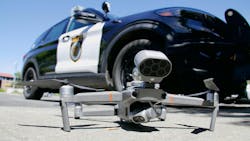Drones as First Responders: How UAVs Change Police Responses
Drones, or unmanned aerial vehicles (UAVs), are rapidly becoming integral tools for police departments across the globe. In recent years, using drones in law enforcement has emerged as a transformative technology, offering significant benefits in response times, situational awareness, and overall public safety.
The Drones as First Responders (DRF) program uses drones piloted remotely to arrive on the scene first, providing an eye in the sky to share updated information. Drones can also provide overwatch, protecting officers on the ground with a wider view of the scene, search assistance, and document scenes through aerial view.
Drone Technology
Drones, or UAVs, are equipped with advanced technology that enables them to perform various tasks autonomously or via remote control. The drone pilot remotely controls the UAV using the video feed and controller. Drone pilots require training and certification to fly UAVs, as well as the necessary law enforcement training to know when and how to use drones when responding to an in-progress call.
Law enforcement drones typically include high-resolution cameras to document the scene. Some drones also have infrared sensors for thermal imaging at night and in other low-light situations. Many UAVs used in public safety have communications components that allow the pilot to communicate with someone on the ground through a speaker and microphone. Some drones can also deliver supplies, such as AEDs, medication, and other life-saving materials.
Integration into Law Enforcement
Integrating drones into law enforcement operations requires a strategic approach to ensure their effective use. Some critical steps for successful integration include developing clear policies and procedures on when to deploy the drones, defining operational protocols, and establishing data management programs.
Drone pilots need training and certification to operate drones within federal guidelines. Consideration should be given to where the drone(s) will be placed as their ‘home base’ as they will need to relaunch from that point for future responses. The security of the program’s drone feed, communications, and base station locations also needs to be addressed.
Public education about the DFR program is also needed, including the benefits of drone use to help build trust. The drone program should also share its deployment practices with neighboring agencies and other public safety entities they work with on scenes where a drone may be deployed.
Privacy Considerations
Using drones in law enforcement raises significant privacy concerns that must be addressed to maintain public trust. Addressing the issues of public concern allows command staff to determine operational and technical best practices as well.
- Data Protection: Measures must be in place to ensure that the data collected by drones is stored securely and used responsibly. This includes encryption and access control to the stored data and a retention plan that follows state guidelines.
- Surveillance Limitations: Policies should clearly define the circumstances under which drones can be used for surveillance to prevent misuse and unwarranted intrusions into private lives.
- Transparency: Law enforcement agencies should be transparent about their drone operations, including the types of data collected and how it will be used. Publicly accessible reports and audits can help maintain accountability.
- Legal Framework: Compliance with existing laws and regulations is crucial. Agencies must stay informed about legal precedents and adapt their practices accordingly.
These items must be shared with the community and those working in the drone program. The Fremont Police Department in California's Unmanned Aerial System (UAS) Operations policy is online, which is helpful to the community.
Drones as First Responder Programs
There are some examples of law enforcement agencies that have implemented successful drone programs, demonstrating the potential of drones as first responders.
Chula Vista Police Department (California): The Chula Vista PD has pioneered using drones as first responders. Their Drone as First Responder (DFR) program involves deploying drones to the scene of an incident before ground units arrive. This allows officers to assess situations in real-time, improving response times and enhancing officer safety. The program has been credited with numerous successful interventions, including locating missing persons and apprehending suspects, as detailed in this video example.
Fremont Police Department (California): Fremont’s DFR program is a joint UAS program with the Fremont Fire Department. Drones responding as part of the DFR often arrive on the scene within two minutes, allowing the pilot to assess the situation and work with responding officers to create a tactical plan when needed.
Colorado agencies: Recently, it was reported that several law enforcement agencies in Colorado were planning to institute a DFR program.
Technology to Aid Public Safety
Drones as first responders represent a significant advancement in law enforcement technology. However, integrating this technology must be carefully managed to address privacy concerns and ensure the ethical use of drones in law enforcement.
With proper policies, training, and public education, drones can become indispensable first responder tools in the quest for safer communities. As technology continues to evolve, the potential for drones in law enforcement will only expand, promising even greater drone success stories in the future.
About the Author
Toni Rogers
Toni Rogers is a freelance writer and former manager of police support services, including communications, records, property and evidence, database and systems management, and building technology. She has a master’s degree in Criminal Justice with certification in Law Enforcement Administration and a master's degree in Digital Audience Strategies.
During her 18-year tenure in law enforcement, Toni was a certified Emergency Number Professional (ENP), earned a Law Enforcement Inspections and Auditing Certification, was certified as a Spillman Application Administrator (database and systems management for computer-aided dispatch and records management), and a certified communications training officer.
Toni now provides content marketing and writing through her company, Eclectic Pearls, LLC.

